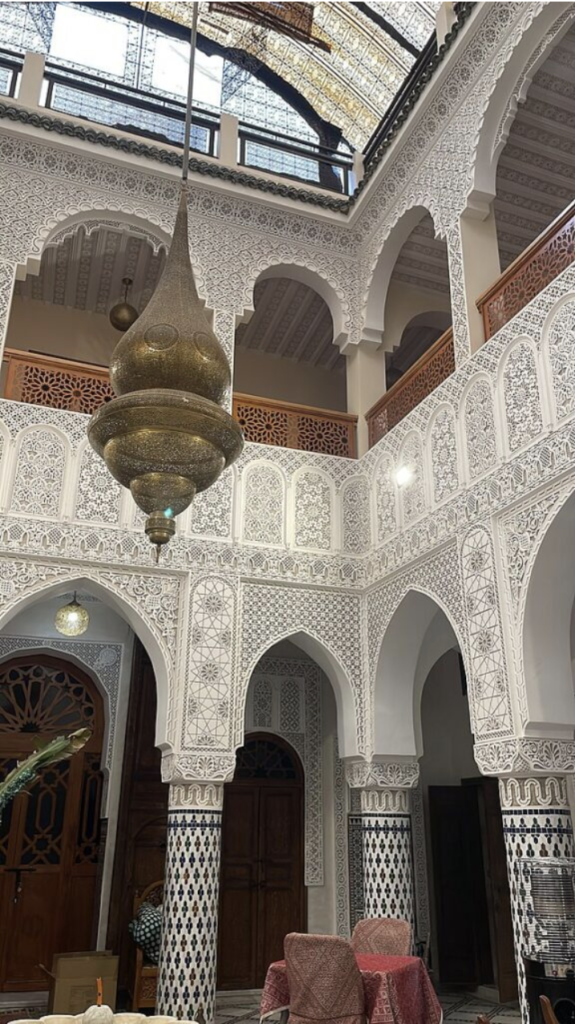Can the Gentrification of Moroccan Riads Tarnish Morocco’s Global Identity?

By: Nissrine Bedda / Arab America Contributing Writer
Riads can date back to the 11th century in Morocco. The exclusive real estate was home to Morocco’s wealthiest families, including merchants and traders. Not only architecturally diverse, but riads have brought great notoriety to Morocco. In the 21st century, the city of Marrakech has become one of the seven wonders in the world to visit. With an influx in foreign tourists, Morocco accomplished a historic record of 10 million tourist arrivals.
This summer alone, the habilitation of hotels doesn’t cut it anymore. Tourists view getting the true Moroccan luxurious experience by staying in a Riad, marking an opportunity for real estate investors to purchase these Riads and adding them on Airbnb. This controversial investment has impacted the surrounding Moroccan communities in major cities like Rabat, Fez, and Marrakech. These historical architectural buildings have begun to lose their cultural significance.
The structure of a Riad:
Many who may have never been to Morocco before might not even be aware of how large these riads truly are. Riads are located in the heart of the “Old Medina” (old city) in any city in Morocco. Through years of modernization, Moroccan cities have expanded to the point where there is a distinct difference between the old and the new. Riads consist of a two-story or multi-story home with a central courtyard, including a pool and a garden.
Moroccan hospitality is well-known throughout the world. From atay (mint tea) to couscous to delectable desserts, it’s no surprise that Moroccan homes are as extravagant as they are. With expansive pillars and grand bedrooms, all surrounded by precise Moorish tile work, riads are intricate pieces of historical architecture. The true owners of these homes hold a binding family lineage dating to the emergence of Morocco itself.
Out with the Old, In with the New?
In July 2024, Morocco welcomed 2.4 million foreign tourists to their nation. Upon their arrivals, with hotels booked, the next option was to book at Airbnb. Now, what’s the issue? While the popular real estate booking app Airbnb can be an expansionary opportunity for the self-employed, the purchasing and renovation of these riads, precisely, has tarnished the Moroccan image. Not only has these renovations disturbed the country’s profile, Europeans have gentrified these custom homes to add their touch of modernism. It’s known that foreigners comprise 70% to 80% of Morocco’s luxury real estate buyers.
What’s wrong with keeping the old? Morocco’s history is deeply ingrained in its national identity, which is renowned around the globe. The boom of Moroccan tourism is a great accomplishment for the Moroccan economy as it has sparked a new project: Operation Marhaba 2030. Launched in 2001, the goal is intended to provide the growing flows of Moroccans residing abroad the best conditions upon their return to Morocco during the summer period. With the intention for the Moroccan diaspora to return to their homeland, the Moroccan diaspora has only been left with a feeling of shock and uneasiness as their land is beginning to show symptoms of gentrification.
I acknowledge that the modernization of Morocco’s infrastructure is a positive development, as it fosters growth across various economic sectors and will likely enhance wages and economic prosperity in the future. However, the challenge lies in preserving Moroccan cultural heritage, encompassing these traditional riads.
The Preservation of Moroccan Architecture
As Moroccans, we are aware of our rich history, food, customs, etc., which make us unique and known worldwide. If Morocco’s goal is to bring Moroccans back home by 2030, it remains true that Moroccans who may have not visited in years would want to come home with the true feeling of home. You know, that hit of nostalgia that comes when you arrive to the bled (“homeland”). That feeling when you turn the corner of your grandmother’s neighborhood and visit your close neighbors or the feeling of the same hanout (“cornerstone”) owned by the same family since the last time you left. Those moments are only a small portion of the comfort of returning home. From the diaspora in Europe, the United States, and the bled, the preservation of culture binds the Moroccan people.
Check out our blog!








